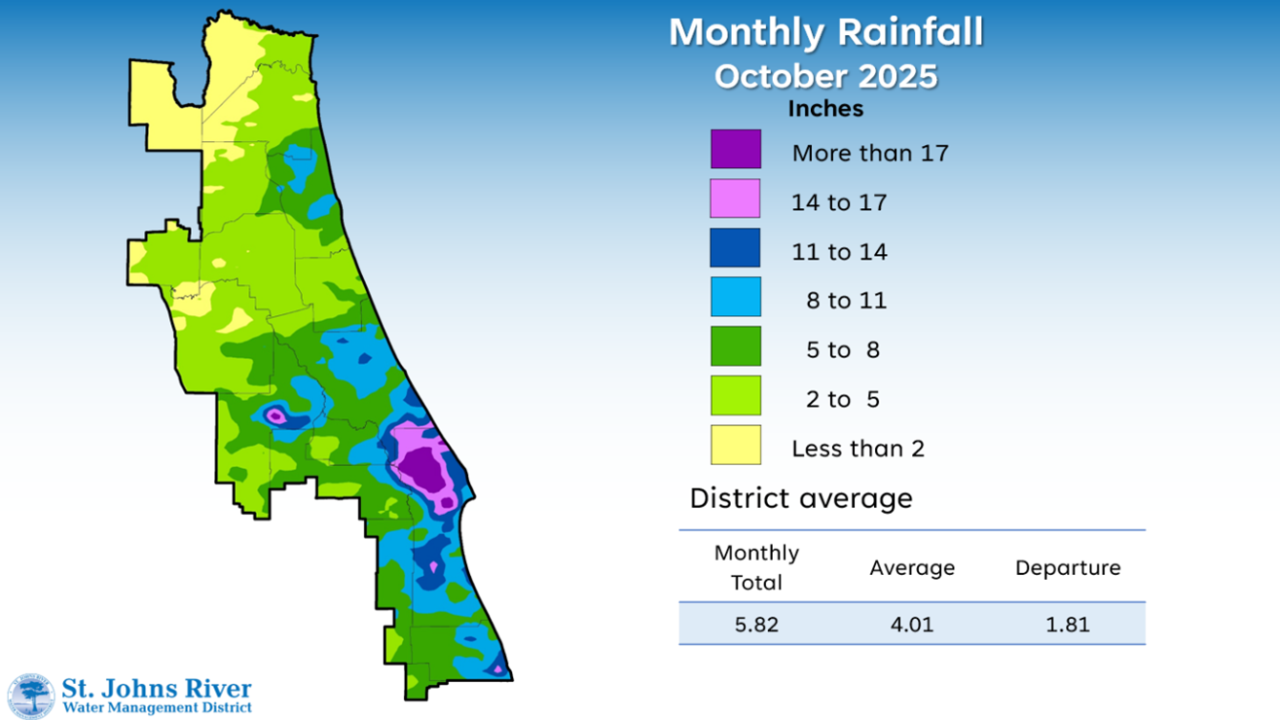October delivers uneven rainfall as La Niña sets in

A map illustrates rainfall conditions in October across the St. Johns River Water Management District.

Rainfall in October was highly varied across the St. Johns River Water Management District (District), showing greater differences than typical for this time of year. While higher rainfall is usually expected along the coast, this month brought extreme contrasts, with peak totals exceeding 22 inches in parts of Brevard County and less than half an inch recorded in some of Baker County.
Against that backdrop, current drought indicators show a mixed picture across the region. Most of the District is not experiencing drought, but portions of the northwest reflect the impact of below-average rainfall, with conditions ranging from moderate drought to abnormally dry. Mild La Niña conditions, according to the National Oceanic Atmospheric Administration’s Climate Prediction Center, are expected to persist through at least December, raising the likelihood of a cooler and drier fall and winter. The National Weather Service’s three-month precipitation outlook points to below-normal rainfall, though with some uncertainty, and the District will continue to monitor these conditions.
With limited rainfall expected in the coming months, residents are encouraged to use water efficiently, such as following water restrictions and adopting smart irrigation practices.
A full report outlining October’s hydrologic conditions was presented at the District’s Governing Board meeting. Highlights include:
Rainfall
- Districtwide rainfall averaged 5.82 inches, 1.81 inches above the monthly average.
- Monthly averages ranged from 12.39 inches in Brevard County to 0.78 inches in Baker County.
- Annual rainfall across the District was 46.60 inches, 4.41 inches below the long-term average.
- Rainfall distribution on an annual scale has been higher in Volusia, northern Brevard and portions of southern counties, while areas to the west and the northwest have received less.
- Fifteen counties have recorded below-average annual rainfall, with five counties more than 10 inches below their annual averages, including Baker County at more than 13 inches below its annual average.
Groundwater
- Water levels in the Upper Floridan aquifer were nearly evenly split, with sites showing increases or decreases that generally follow recent rainfall distribution.
- Districtwide groundwater levels, expressed as a single index, were in the 42nd percentile, which is in the normal range for this time of year.
Spring flows
- Silver Springs recorded a monthly mean flow of 546 cubic feet per second (cfs), or 355 million gallons per day (mgd), a decrease of 11 cfs from September. This is near the top of the low range for this time of year.
- In Volusia County, the Blue Spring station reported flows to be in the normal range based on available data.
- Rock Springs had a monthly mean flow of 61 cfs (39 mgd), which is in the normal range.
- Wekiwa Springs recorded a monthly mean flow of 66 cfs (42 mgd) continuing to be in the normal range.
For further insights into rainfall totals and other hydrologic data, visit www.sjrwmd.com.
Visit WaterLessFlorida.com for tips to help landscapes thrive while saving water and money. Follow the water conservation conversation at #sjrwmd #waterconservation #savewater.





